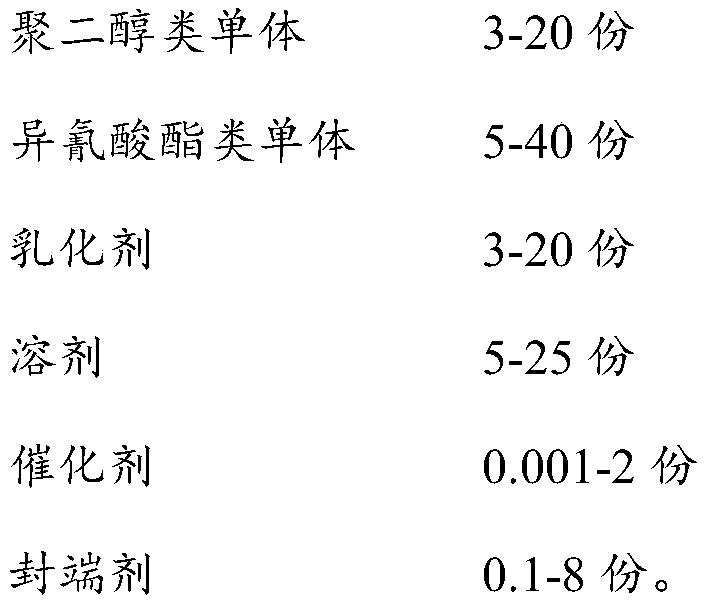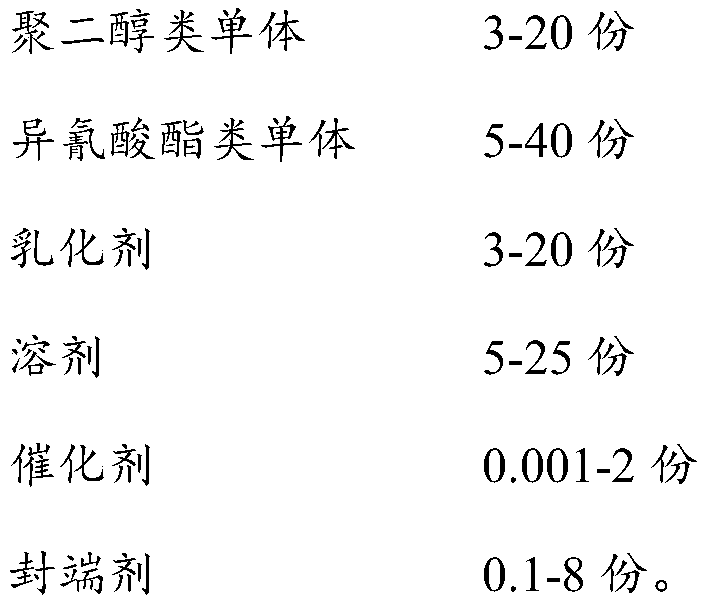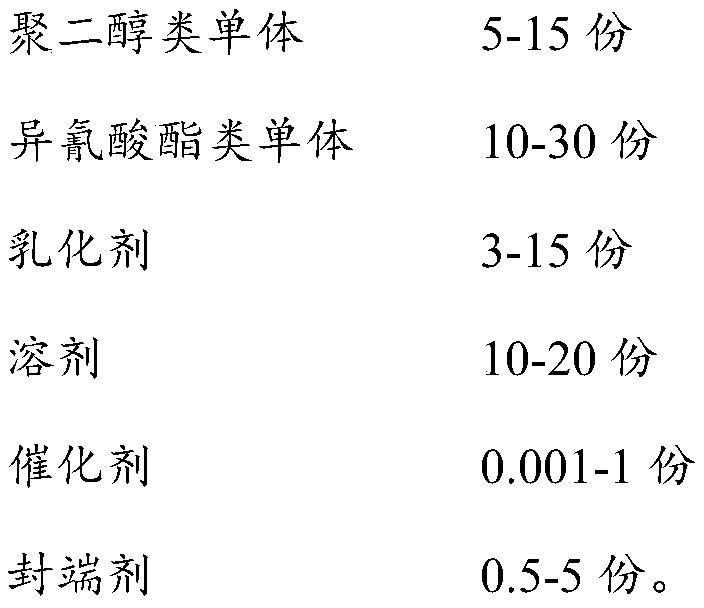Waterborne polyurethane dispersing agent and waterborne color paste containing same
A water-based polyurethane and dispersant technology, applied in the direction of pigment paste, etc., can solve the problems that the color paste is prone to delamination or floating color, and the dispersant cannot achieve the dispersing effect, so as to achieve the effect of strong dispersing ability and good stability
- Summary
- Abstract
- Description
- Claims
- Application Information
AI Technical Summary
Problems solved by technology
Method used
Image
Examples
Embodiment 1
[0039] Nitrogen gas was passed into a dry and clean four-necked flask equipped with a stirring and condensing reflux device, and sulfolane 200g, polycarbonate diol UH-50 148g, 2,2-dimethylolpropionic acid (DMPA ) 96g, tetrabutyl titanate 10g, poured into the reactor, stirred evenly and heated, the temperature was controlled at 60°C. Then add 262g of tetramethyl-m-xylylene diisocyanate TMXDI into the reaction flask for reaction, and use the slow drop method to add slowly and uniformly with a peristaltic pump. The addition time is 90min, and the reaction temperature is 60°C; after the addition, the temperature rises To 100°C, stir evenly until the concentration of isocyanate group (%NCO) is lower than 1.5%, then cool down to 60°C. Then, 30 g of triethylamine TEA was slowly added into the reaction flask, and the addition was completed in 5 minutes, and stirred evenly at 60° C. for 1 hour to obtain a dispersant prepolymer. Finally, add 133.2g of 3% potassium hydroxide aqueous sol...
Embodiment 2
[0041]In a dry, clean four-necked flask with a stirring and condensing reflux device, nitrogen gas was introduced, and 150 g of dimethyl sulfoxide, 68 g of polycarbonate diol UH-100, and dimethylol butyric acid (DMBA ) 52g, dibutyltin dilaurate 0.01g, pour into the reactor, stir evenly and heat, control temperature 60 ℃. Then add 126g of dicyclohexylmethane diisocyanate HMDI into the reaction flask for reaction. Slowly drop the method and use a peristaltic pump to add slowly and uniformly. The addition time is 60min, and the reaction temperature is 60°C; after the addition, the temperature is raised to 100°C. Stir evenly until the concentration of isocyanate group (%NCO) is lower than 1.5%, and cool down to 60°C. Then add 16.7g of diethylamine DEA into the reaction flask, finish adding in 5 minutes, and stir evenly at 60°C for 1 hour to obtain a dispersant prepolymer. Finally, add 187.3g of 3% sodium hydroxide aqueous solution to the above-mentioned dispersed prepolymer for 1...
Embodiment 3
[0043] In a dry and clean four-necked flask equipped with a stirring and condensing reflux device, nitrogen gas was introduced, and 100 g of dimethyl sulfoxide, 102 g of polytetramethylene ether glycol TETRATHANE 650, and 2,2-dihydroxy 86.9g of methacrylic acid (DMPA) and 1g of stannous octoate were poured into the reactor, stirred evenly and heated, and the temperature was controlled at 60°C. Then, 152g of m-xylylene dimethyl isocyanate MXDI was added into the reaction flask for reaction, and the reaction was carried out by slowly dropping The way of adding is to use a peristaltic pump to add slowly and evenly, the adding time is 70min, and the reaction temperature is 60°C; after the addition, the temperature is raised to 100°C, and the mixture is stirred evenly until the concentration of isocyanate (%NCO) is lower than 1.5%. Cool down to 60°C. Then add 6.8 g of bis(2-methoxyethyl)amine BMEA into the reaction flask, finish adding in 5 minutes, and stir evenly at 60° C. for 1 ...
PUM
 Login to View More
Login to View More Abstract
Description
Claims
Application Information
 Login to View More
Login to View More - R&D
- Intellectual Property
- Life Sciences
- Materials
- Tech Scout
- Unparalleled Data Quality
- Higher Quality Content
- 60% Fewer Hallucinations
Browse by: Latest US Patents, China's latest patents, Technical Efficacy Thesaurus, Application Domain, Technology Topic, Popular Technical Reports.
© 2025 PatSnap. All rights reserved.Legal|Privacy policy|Modern Slavery Act Transparency Statement|Sitemap|About US| Contact US: help@patsnap.com



